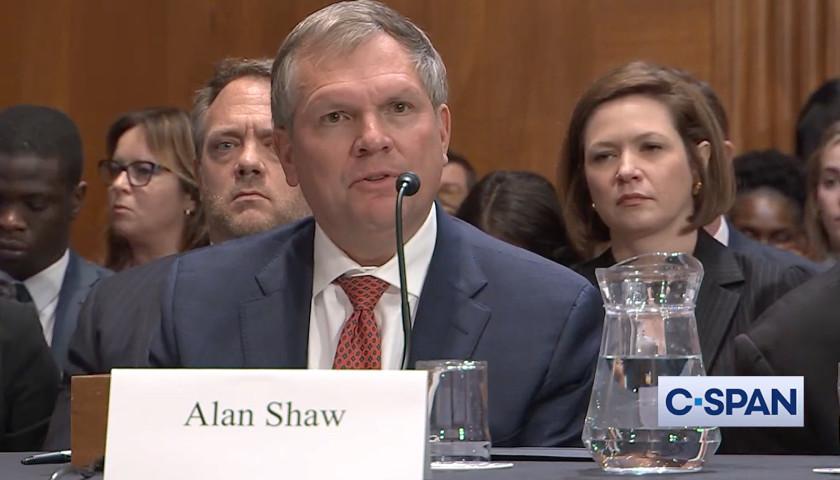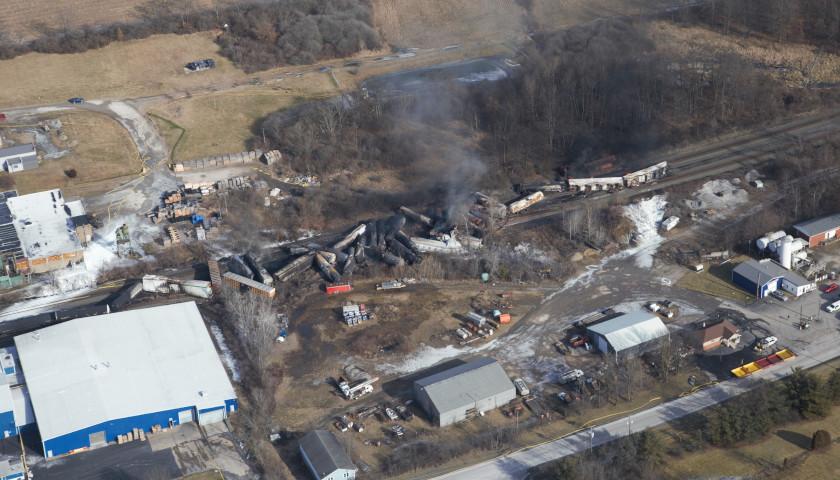Norfolk Southern CEO Alan Shaw faced questions about who authorized the controlled burn at a Senate hearing on Thursday as Washington lawmakers held their first hearing on railroad safety about a month after a train carrying toxic chemicals derailed in East Palestine, Ohio.
U.S. Senator Markwayne Mullins (R-OK) asked Shaw “when the vent and burn process was being made, who made those decisions and what were the considerations other than just burning it and letting the material burn off.”
Shaw told the Senate committee that “the only consideration was the safety and health of the community and that the decision was made by a unified command under the direction of the incident commander.” Shaw did not identify the members of the unified command but that Norfolk Southern was one of them.
His comments confirmed what a spokesperson with the U.S. Environmental Protection Agency (EPA) Region 5 told The Ohio Star last month that the incident commander was Fire Chief Keith Drabick of the East Palestine Fire Department.
“The incident commander was Fire Chief Drabick. Norfolk Southern was part of the unified command,” Shaw said.
Shaw was not asked, nor did he comment, if he provided the legal authority by which the burn was authorized.
On February 3rd, 50 train carriages, 10 of which were carrying hazardous materials, derailed as a result of a technical problem with a rail car axle, according to federal authorities. There was vinyl chloride in five of the vehicles. Hundreds of residents evacuated due to the controlled release of poisonous gasses that Norfolk Southern carried out on February 6th to stop an explosion.
Officials told East Palestine residents on February 8th that they could safely go home, despite the reports of hundreds of dead fish in the Ohio River near East Palestine and residents complaining of headaches and illness since the derailment.
Shaw informed the committee that no railroad owns the tank car in question, but a private entity owns the rail car, and the lessor and the customer share the responsibility for the contents and operations of the rail car.
When asked if the unified command considered the owner in the decision-making process to vent and burn the rail car Shaw said “the customer provided input.”
According to Mullins, he received reports that the rail car in question was functioning properly at the time of the burn and that the unified command did not consult the cars’ owners prior to the burn.
“The report that I received said that the car was actually working properly at the time but the cars’ owners, the ones that were responsible for it weren’t consulted before it was burnt off. Now I haven’t been able to verify that but I’m asking these questions because that’s the information I received and if that’s the case I think that’s an area for improvement,” Mullins said.
Shaw said that he could not confirm the accuracy of Mullin’s report but that his understanding at the time was that “we were at risk of a catastrophic rupture that would have resulted in an uncontrolled release of hazardous materials.”
According to Mullins, the unified command should have consulted those responsible for the rail car before they decided to burn the rail car.
“If this car was designed by someone else and if this car was owned by somebody else and the function of the car was designed by somebody else and was responsible by somebody else then how do we know that the car wasn’t working properly to begin with. If they weren’t in the room during the decision making and yet it was their car and the report may be accurate that the car was working functionally correctly because these cars are designed for these types of incidents that the option to vent and burn may not have been the best option if we didn’t consider all other options first,” Mullins said.
Shaw reiterated that “the only consideration was the safety and health of the community.”
U.S. Senators JD Vance (R-OH) and Sherrod Brown (D-OH) who introduced bipartisan railroad safety legislation last week, appeared as witnesses, along with representatives from the Environmental Protection Agency (EPA), Ohio EPA, Beaver County Department of Emergency Services and Ohio River Valley Water Sanitation Commission.
“I think the most important message to the people of East Palestine is that we will not forget about them in the months and years to come and I think this committee hearing reinforces that message,” Vance said.
– – –
Hannah Poling is a lead reporter at The Ohio Star and The Star News Network. Follow Hannah on Twitter @HannahPoling1. Email tips to [email protected]





